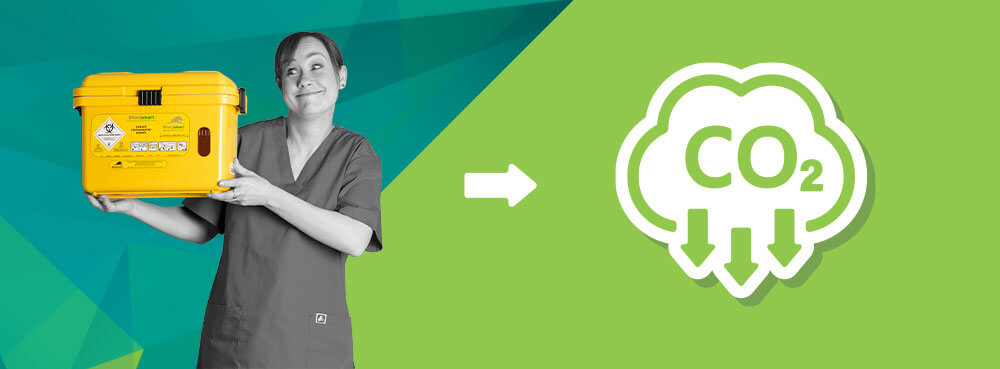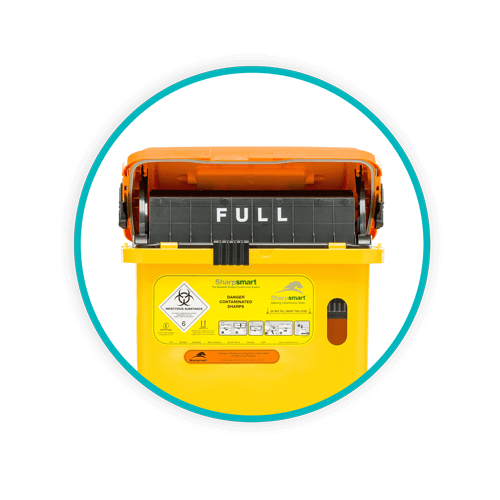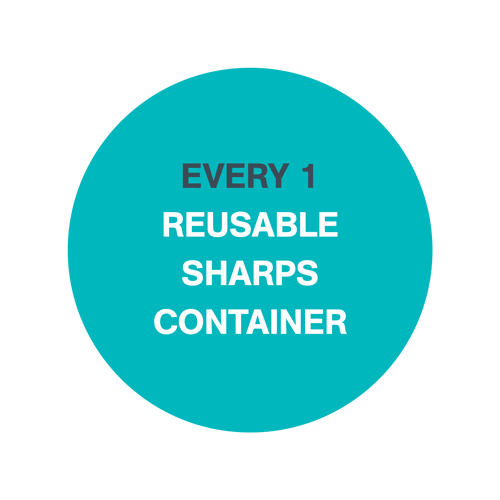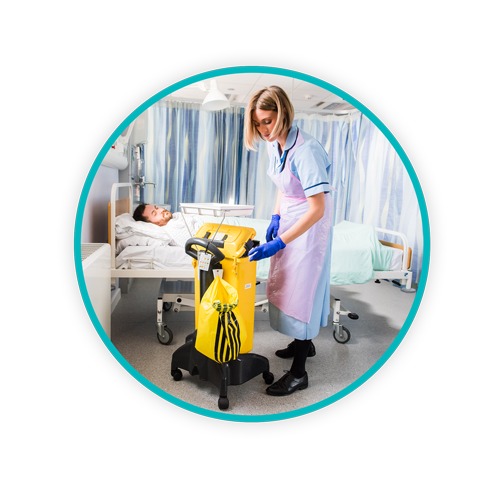5 Ways to Reduce Your Carbon Footprint Within Waste Management

With a net zero future on the horizon for the NHS and growing concerns about the environment, healthcare facilities are looking for additional ways to drive positive change and introduce more sustainable practices.
Optimising waste management and improving waste segregation practices is an effective way for any healthcare facility to drastically reduce its carbon footprint and improve overall sustainability efforts. Let’s dive in and look at five ways to reduce your carbon footprint within waste management.
5 WAYS TO REDUCE YOUR CARBON FOOTPRINT:
2 / Reduce single-use plastics
3 / Introduce new waste streams
4 / Specific waste containment placement
5 / Implement a reusable waste containment system
Time and again, the implementation of an optimised waste management solution has been proven to reduce global warming potential and the negative impacts of climate change. In fact, you can make a significant contribution to reducing your carbon emissions by optimising your waste management practices and work towards a net zero future.
Here are five ways you can optimise your waste management and help your facility reduce its carbon footprint and improve its sustainability efforts:
1. Maximise container usage
Sometimes, waste containers are collected when they’re only half full, meaning that another container has to take its place. This cycle of collecting and replacing half-filled containers can go on and on and they soon add up.
If they’re single-use containers, additional carbon emissions are being generated at both the point of manufacture of the new container and at end disposal. Alongside this, there’s unnecessary cardboard packaging and increased transport to take the container to its disposal outlet.
Similarly, for reusable containers, if they are ‘turned’ too early, this means there’s increased transport to move the container to a treatment facility.
By filling containers to their maximum capacity or ‘fill’ line, containers will only be collected when full; driving efficiencies in the transport and treatment of containers and the contained waste, resulting in significant carbon reductions.
2. Reduce single-use plastics
Implementing a reusable waste containment system will significantly reduce the amount of single-use plastic being manufactured and disposed of via high-temperature incineration.
 Using a reusable system doesn’t only reduce plastic, it will also reduce the large volumes of cardboard packaging associated with the transport and movement of single-use containers.
Using a reusable system doesn’t only reduce plastic, it will also reduce the large volumes of cardboard packaging associated with the transport and movement of single-use containers.
40 trusts across the UK that converted to reusables eliminated the incineration of 900.8 tonnes of single-use plastic and eliminated the disposal/recycling of 132.5 tonnes of cardboard within 12 months of converting.
Learn more about the before/after intervention study to determine impact on life-cycle carbon footprint of converting from single-use to reusable sharps containers in 40 UK NHS trusts.
3. Introduce new waste streams
To mix waste streams or not to mix waste streams, that is not the question! Poor waste segregation practices can significantly impact your carbon emissions, and not in a good way.
The HTM guidance for the safe management of healthcare waste details the different types of waste generated within healthcare facilities and the waste streams these waste types are associated with. Each waste stream has an allocated disposal and treatment method that ensures the waste is rendered safe and where possible, drives sustainable outcomes.
Introducing waste streams such as ‘offensive’ helps reduce the amount of waste sent for alternative treatment and high-temperature incineration and diverts the waste to more sustainable outlets. See how North West Anglia NHS Foundation Trust achieved an 87% diversion of healthcare waste from high-temperature incineration through the implementation of new waste streams.
4. Specific waste containment placement
Here’s a scenario for you. You’ve just treated a non-infectious patient and you need to discard of your gloves which are not contaminated with any chemical or medicinal properties. There’s a bin next to you with an orange bag in it, and there’s no offensive waste stream in sight. What do you do?
Hopefully you answered: locate the offensive waste stream and discard of your gloves within it. But we know your time is precious and this isn’t always feasible. So, in this scenario you may have chucked those gloves straight into the orange infectious waste stream, resulting in the overtreatment of waste.
Overtreating waste causes unnecessary carbon emissions. By ensuring waste containment solutions, whether you’re using bags or containers, are placed in the areas you need them, you’ll be able to avoid this and practice correct and compliant waste segregation (putting the right waste in the right bin).
It also means that you’ll avoid the unnecessary blind panic of trying to locate the correct bin when you’ve got more important things to be getting on with! The same goes for areas in hospitals such as theatres. By placing metal recycling containers within these areas, you’ll increase the recycling of single-use metal instruments which is much better for the environment! Liverpool Women’s Hospital managed to overcome this problem and divert 40% of their waste from clinical to offensive streams within 6 months of implementing correct container placement.
5. Implement a reusable waste containment system
We’ve mentioned reusable containers a couple of times in this blog, so let’s dig into the detail a little more.
Reusable containers do exactly what they say on the tin; they’re reusable. Containers such as those provided by Sharpsmart can last for anything up to 500 washes. Just think about that for a second. A single container can be used around 500 times, that’s a lot of single-use plastic saved and therefore provides a significant reduction in waste volumes and associated carbon emissions.
Furthermore, as reusable containers are not disposable, they generally come with some form of waste management support. This means you can get expert guidance on the correct management of waste streams, ensuring you have the right container size and type for the waste you produce.
The results of this? Waste is sent to the most sustainable disposal outlet available, waste is collected only when containers are full and you’ll see major reductions in single-use plastic, cardboard packaging, and your carbon footprint. Learn more about how reusable containers assist in cutting carbon emissions.
Are You Reducing Your Carbon Footprint With Waste Management?
Sharpsmart provides fully managed healthcare waste management solutions that have proven results of significant reductions in CO₂e.
We provide far more than a waste removal service, we’ll also be on hand to support you in implementing an optimised waste management strategy and educating your staff on waste segregation best practices. We’re dedicated to driving value in sustainability and exceeding benchmarks, supporting our partners on the route to net zero. To learn more about reducing your carbon footprint with waste management, contact us today.
Let's Talk!
Your time is valuable, and we don’t want to play hard to get. You can either phone us directly on the details listed on our contact page, or feel free to fill out this short form and one of our team members will get back to you as quickly as possible.
